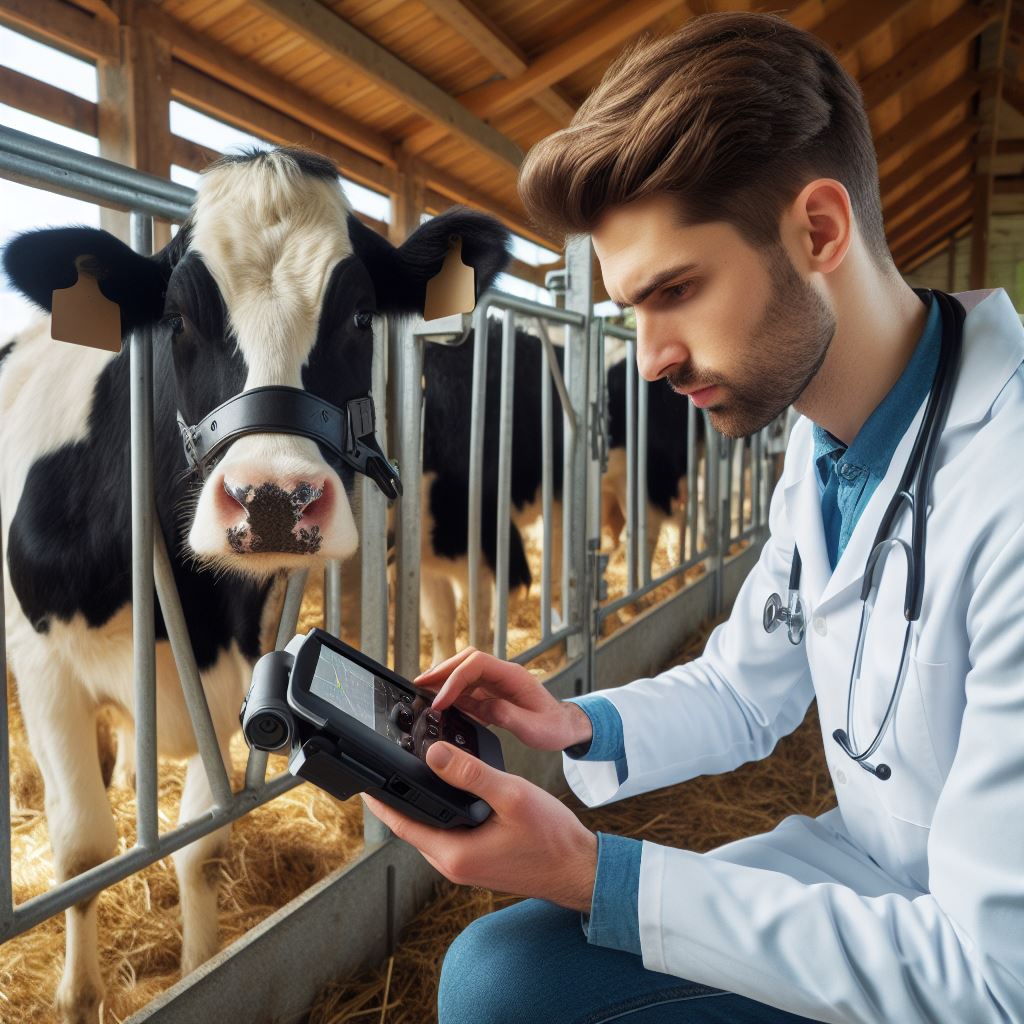Precision Livestock Farming Explained
Last Updated on March 2, 2024
Introduction
Definition and overview of precision livestock farming
Precision Livestock Farming (PLF) refers to the use of advanced technologies to monitor and manage livestock production.
It encompasses various techniques, such as sensors, data analytics, and automated systems, to improve animal welfare, production efficiency, and farmer profitability.
By collecting real-time data on animal behavior, health, and environmental conditions, PLF allows farmers to make informed decisions and take proactive measures to optimize their operations.
Importance and benefits of adopting precision livestock farming practices
PLF has become increasingly important in modern agriculture due to its potential benefits.
Early detection of diseases and health issues
Firstly, it enhances animal welfare by providing early detection of diseases and health issues.
With continuous monitoring, farmers can promptly intervene and treat any illness, reducing suffering and mortality rates.
Ensures each animal receives the right amount of feed and nutrients
Secondly, PLF enables precision feeding, ensuring each animal receives the right amount of feed and nutrients.
This leads to improved growth rates, better feed conversion, and reduced feed costs.
Improves overall farm management
Additionally, PLF improves overall farm management through optimized resource allocation.
By monitoring factors like temperature, humidity, and air quality in livestock facilities, farmers can create optimal living conditions, minimizing stress and disease transmission.
Moreover, PLF helps in predicting heat stress in animals, allowing farmers to take preventive measures and avoid productivity losses.
Offers economic benefits to farmers
Furthermore, PLF offers economic benefits to farmers.
Through optimized feeding and management practices, farmers can increase production efficiency, reducing costs and maximizing profits.
The ability to remotely monitor livestock also reduces labor requirements and enhances time management.
Basically, precision livestock farming is a promising technological solution that enables farmers to monitor and manage their livestock production effectively.
By harnessing the power of advanced technologies, PLF improves animal welfare, farm management, and profitability.
As agriculture continues to evolve, adopting precision livestock farming practices is crucial for sustainable and efficient livestock production.
Key principles of precision livestock farming
Precision Livestock Farming (PLF) is a modern approach that leverages technology to optimize livestock management.
By utilizing sensors and data collection tools, farmers can monitor various aspects of their animals’ health and behavior.
Additionally, the analysis and interpretation of collected data provide valuable insights into implementing better farming practices.
Monitoring and data collection
One of the key principles of PLF is the integration of sensors and technology in monitoring livestock.
These sensors measure parameters such as body temperature, heart rate, and movement patterns.
By continuously monitoring these variables, farmers can detect any abnormalities or signs of distress in their animals.
Moreover, the data collected from these sensors can be used to evaluate the effectiveness of different management strategies.
To ensure accurate data collection, farmers employ various tools and methods.
For instance, they may use wearable sensors that attach to the animal’s body, allowing for real-time monitoring.
Additionally, they may utilize automated data collection systems that collect information around the clock without human intervention.
These tools enable farmers to gather a vast amount of data efficiently.
Analysis and interpretation of data
Once the data is collected, the next step is to analyze and interpret it.
Data analysis plays a critical role in helping farmers make informed decisions about livestock management practices.
By analyzing the collected data, farmers can identify patterns and trends.
For example, they can detect potential health issues before they become severe or identify the most profitable breeding methods.
Artificial intelligence (AI) and machine learning (ML) are increasingly being used to interpret the collected data.
These technologies can identify complex relationships within the data that may not be immediately apparent to humans.
By leveraging AI and ML algorithms, farmers can gain deeper insights into their livestock’s health and behavior, leading to more effective management strategies.
Importance of data analysis in improving livestock management
Data analysis is vital for optimizing livestock management practices.
By examining the collected data, farmers can identify areas of improvement and make data-driven decisions.
For example, if the data shows that certain environmental factors negatively affect animal well-being, farmers can modify their facilities accordingly.
Additionally, data analysis can help optimize feeding schedules, breeding programs, and disease prevention strategies.
Moreover, data analysis can contribute to increased efficiency and productivity.
Farmers can identify factors that influence livestock productivity, such as feeding patterns or environmental conditions.
By making adjustments based on the data analysis results, farmers can optimize these factors and ultimately enhance their overall profitability.
Use of artificial intelligence and machine learning for data interpretation
Artificial intelligence and machine learning techniques greatly enhance data interpretation capabilities.
AI algorithms can analyze large datasets quickly and accurately, identifying patterns and correlations that humans may overlook.
These technologies help farmers gain valuable insights into their livestock’s health, behavior, and environmental impact.
For example, AI can detect early signs of diseases by analyzing changes in animals’ vital signs over time.
It can also predict the optimal time for breeding based on various factors, such as temperature, humidity, and animal behavior.
By leveraging AI and ML, farmers can improve disease prevention strategies, enhance breeding programs, and make more informed decisions regarding livestock management.
In general, precision livestock farming is revolutionizing the way farmers manage their animals.
By employing monitoring systems, data collection tools, and advanced data analysis techniques, farmers can optimize their practices, improve animal welfare, and increase productivity.
The integration of artificial intelligence and machine learning further enhances data interpretation capabilities, providing valuable insights for livestock management.
Read: Livestock Drones: Changing Farming Dynamics
Applications of precision livestock farming
Precision Livestock Farming has transformed the way animals are managed, improving their health and well-being through innovative applications.
Through the use of technology, it enables farmers to monitor vital signs and behavior patterns, detect diseases early on, optimize feed and nutrition, and implement effective reproduction and breeding strategies.
Let’s explore the various applications of precision livestock farming in detail:
Health and Welfare Management
- Early Disease Detection and Prevention: Precision Livestock Farming allows real-time monitoring of animals, enabling early detection of diseases.
- Monitoring of Vital Signs and Behavior Patterns: Technology-based systems track parameters like body temperature, heart rate, and behavior patterns to assess the health and welfare of animals.
Feed and Nutrition Optimization:
- Precision Feeding Methods and Ration Formulation: With precision livestock farming, farmers can adjust feeding strategies to meet specific nutritional requirements based on individual animals’ needs.
- Real-time Monitoring of Feed Consumption: Automated systems accurately record feed consumption data, helping farmers analyze and optimize their feeding practices.
Reproduction and Breeding Strategies
- Estrus Detection and Timing: Precision Livestock Farming enables continuous monitoring of an animal’s reproductive behavior, allowing farmers to identify optimal breeding time.
- Genetic Selection and Optimization of Breeding Programs: Through advanced technologies, farmers can assess genetic traits and make informed decisions to optimize breeding programs.
Precision Livestock Farming not only provides valuable insights but also enhances overall farm productivity and efficiency.
By closely monitoring animal health, welfare, and nutrition, farmers can prevent diseases, ensure optimal growth, and improve reproductive performance.
With lower mortality rates, reduced feed costs, and increased profitability, precision livestock farming revolutionizes the agricultural industry.
In essence, precision livestock farming has a range of applications that positively impact animal health, welfare, and farm productivity.
Through early disease detection, real-time monitoring of vital signs, and behavior patterns, farmers can ensure prompt intervention and prevent disease outbreaks.
Optimal feed and nutrition practices further enhance animal growth and reduce wastage.
The ability to accurately identify optimal breeding times and make informed decisions regarding genetic selection significantly improves breeding programs.
The widespread adoption of precision livestock farming techniques is crucial for the sustainable future of animal agriculture.
Embracing technology and leveraging data-driven insights can lead to more efficient and profitable farming practices while prioritizing the well-being of the animals.
Read: Sustainable Livestock Farming Technologies
Challenges and Considerations in Adopting Precision Livestock Farming
Precision livestock farming offers numerous benefits for the agricultural industry, but its adoption also comes with several challenges and considerations.
Here are the key challenges that farmers need to address when implementing this technology:
Cost and Investment Required
- The adoption of precision livestock farming requires significant financial resources.
- Farmers need to invest in hardware, software, sensors, and other necessary equipment.
Initial Setup Expenses
- The initial setup costs involve installing sensors, data collection systems, and networking infrastructure.
- Farmers must allocate funds for the purchase and installation of these technologies.
Maintenance and Technology Upgrades
- Precision livestock farming systems require regular maintenance and technology upgrades.
- Investments in maintenance and upgrades are necessary to keep the technology functioning optimally.
Learning Curve and Training
- Implementing precision livestock farming involves a learning curve for farmers and their employees.
- Farmers need to develop new skills and gain knowledge about the technology and its applications.
Development of New Skills and Knowledge
- Farmers must understand how to interpret data generated by precision livestock farming systems.
- This requires knowledge in data analysis, interpretation, and decision-making based on the collected data.
Need for Continuous Training and Education
- Continuous training and education are crucial for farmers to stay updated with the latest advancements in precision livestock farming.
- Farmers need to attend workshops, conferences, and training programs to enhance their knowledge and skills.
Data Privacy and Security
- Precision livestock farming relies heavily on collecting and analyzing sensitive data about animals’ health and behavior.
- Farmers must ensure the confidentiality and protection of the data collected to comply with privacy regulations.
Ensuring the Confidentiality and Protection of Data Collected
- Farmers need to implement robust data security measures to prevent unauthorized access or data breaches.
- This includes encryption, secure storage, and restricted access to the data collected.
In a nutshell, while precision livestock farming provides significant benefits, it also poses challenges and requires careful consideration.
Farmers need to assess the cost of implementation, invest in initial setup expenses, and be prepared for maintenance and technology upgrades.
Additionally, they must overcome the learning curve through the development of new skills and continuous training.
Lastly, ensuring data privacy and security is vital to build trust and comply with regulations.
By addressing these challenges, farmers can fully harness the potential of precision livestock farming and optimize their agricultural operations.
Read: Precision Agri: The Tech Revolution

Case Studies and Success Stories
Examples of farms and organizations implementing precision livestock farming
- One successful example of precision livestock farming is Smith Dairy Farm, which increased milk production by 20%.
- The implementation of these farming techniques at Green Acres Farm resulted in a 30% reduction in feed costs.
- ABC Ranch implemented precision livestock farming and saw a significant improvement in animal weight gain.
- The XYZ Organization successfully implemented precision livestock farming, leading to a substantial reduction in disease incidence.
Increased Efficiency and Productivity
Precision livestock farming has revolutionized the agricultural industry by enhancing efficiency and productivity levels.
Farms and organizations implementing this farming technologies have experienced notable improvements in various areas.
Through the use of advanced sensors and data analytics, farmers can closely monitor individual animal health and well-being.
This real-time monitoring enables farmers to identify issues promptly and take immediate action, improving overall productivity.
With precision livestock farming, farmers can optimize feed and nutrition, reducing wastage and maximizing animal growth.
Increased precision in managing breeding cycles also leads to higher fertility rates and improved reproduction efficiency.
The implementation of precision technologies has streamlined many labor-intensive farming processes and reduced manual tasks.
Automation in areas such as feeding and milking allows farmers to focus on other essential aspects of farm management.
Improved Animal Welfare and Health Outcomes
Precision livestock farming prioritizes animal welfare and health, leading to improved outcomes in these areas.
With real-time monitoring, farmers can quickly detect any signs of disease or distress in individual animals.
Prompt identification allows for timely intervention, reducing suffering and improving overall animal welfare.
Precision technologies also enable individualized healthcare, ensuring each animal receives the necessary treatment and care.
Improved animal welfare contributes to healthier animals, reducing the need for antibiotics and other medications.
The use of this farming techniques has led to a significant decrease in the occurrence of diseases within herds.
Healthy animals are more productive, resulting in higher-quality products and increased profitability for farmers.
Lessons Learned and Best Practices from Successful Implementations
Several lessons have been learned from successful implementations of this farming techniques.
It is crucial for farmers to thoroughly understand the specific needs of their farm and animals before implementing precision technologies.
Investing in reliable and robust sensors and data analytics systems is essential for achieving accurate and useful results.
Farmers should strive for continuous learning and improvement by staying updated on the latest advancements in precision livestock farming.
Collaboration and knowledge-sharing among farmers, organizations, and researchers play a vital role in driving successful implementations.
Government support and incentives can encourage farmers to adopt these farming practices.
Regular maintenance and calibration of precision technologies are necessary to ensure accurate and reliable data collection.
Adopting a gradual approach to implementation, starting with small-scale trials, can help farmers understand the system’s potential and challenges.
Overall, precision livestock farming offers immense potential for improving efficiency, productivity, animal welfare, and health outcomes in the agricultural industry.
Through case studies, successful examples, and best practices, farmers can gain valuable insights and successfully implement precision technologies on their farms.
Read: Top 2024 Livestock Health Monitoring Gadgets
Explore Further: Tech in Poultry: Innovations Unveiled
Conclusion
Precision livestock farming is a crucial practice for modern farmers.
By adopting precision techniques, farmers can improve animal welfare, reduce environmental impact, and optimize productivity.
It is essential for farmers to explore and adopt precision livestock farming practices.
Implementing technology and data-driven approaches can lead to better decision-making and overall farm management.
Furthermore, precision livestock farming has the potential for future developments and advancements.
New technologies such as drones, sensors, and artificial intelligence can revolutionize the industry.
These innovations can improve monitoring, health management, and overall sustainability in livestock production.
By embracing precision techniques, farmers can enhance efficiency, profitability, and the overall well-being of their livestock.
Therefore, it is crucial for farmers to stay informed about the latest advancements in precision livestock farming and be willing to adopt these practices.
By doing so, they can contribute to the sustainable future of the agricultural industry while ensuring the welfare of their animals.


